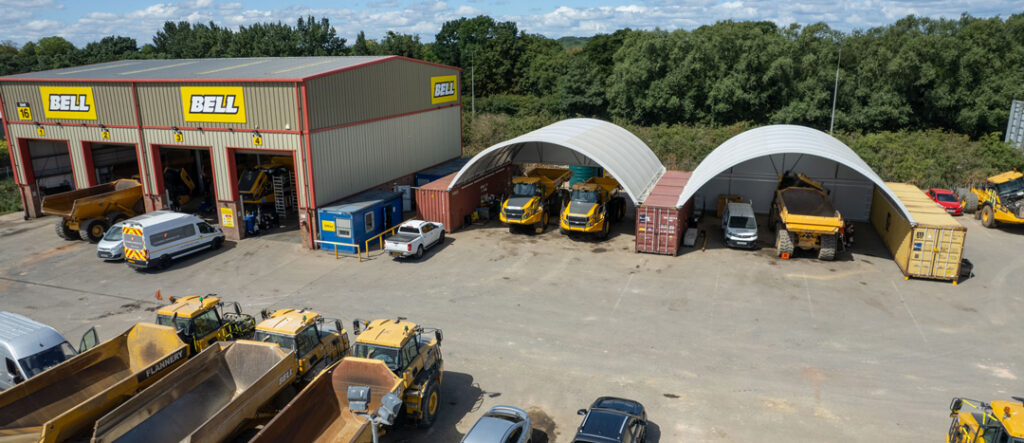In the commercial storage market, choosing between traditional buildings and modular structures can have a considerable impact on a company’s operational agility and overall efficiency. While traditional buildings have long been the norm, modular structures such as canopies and container canopies are emerging as adaptable alternatives, providing unrivalled flexibility and adaptation to changing business requirements.
This article will compare the benefits of modular structures like Shield Canopy™ to traditional buildings and how they can improve business performance through reconfigurability.
What is Shield Canopy™?
Shield Canopy™ is a modular container canopy designed to satisfy a variety of commercial and industrial requirements. Shield Canopy, made in the UK with diligent attention to quality, has rapid deployment capabilities, with installations completed in 48-72 hours.
Its relocatable design allows for smooth movement to meet changing company needs, while quick dismantling and storage ensures the best space utilisation. Shield Canopy™, built to endure harsh weather conditions, offers better durability and protection for staff and assets. It is the best alternative for businesses seeking cost-effective, customisable, and sustainable storage options.
How does Shield Canopy™ differ from other commercial storage types in responding to operational changes?
Adaptability to operational change
Commercial storage types frequently lack the flexibility to respond quickly to changing operational needs. Expansion or downsizing usually entails expensive and time-consuming construction processes. In contrast, modular structures such as canopies and container canopies have a modular design that allows for easy scaling.
Shield Canopy™ structures have modules that can be easily removed or repurposed, allowing businesses to adapt to changing demands without major capital expenditure or downtime.
Speed of deployment
Time is critical in today’s fast-paced business world. Traditional building construction can take months or even years to complete, delaying businesses and limiting development options. Modular buildings, on the contrary, may be quickly deployed and put together on-site. Prefabricated components simplify the installation process, considerably shortening construction schedules.
For organisations that want rapid commercial storage or must respond to sudden market developments, modular buildings provide a quick and effective option that reduces lead times and increases productivity.
Cost-effectiveness
Cost considerations are vital in any company’s decision. Traditional building construction incurs significant upfront costs, including materials, manpower, and permits. Maintenance and upkeep expenditures can add up over time for various commercial storage types. In contrast, modular structures offer a more cost-effective approach.
Their standardised components and assembly procedure lower building costs while eliminating the need for significant groundwork. Furthermore, the adaptability of modular structures enables organisations to optimise their investment by repurposing or shifting modules as needed, maximising long-term value while minimising costs.
Customisation and configurability
One of the primary benefits of modular structures is their inherent adaptability. Unlike traditional buildings, which frequently require substantial redesign to meet changing needs, modular structures provide a customisable framework that can be adjusted to individual needs. Canopies and container canopies, for example, can be customised with different sizes, layouts, and features to meet a variety of storage requirements.
This versatility allows firms to optimise storage space, increase workflow efficiency, and improve overall operational performance. Whether it’s optimising inventory management or providing defined work zones, modular structures give businesses the freedom to build spaces that meet their operational goals.
Sustainability and environmental impacts
In a time of increased environmental consciousness, sustainability is critical. Traditional building construction can result in enormous waste and carbon emissions, which contribute to environmental degradation. Modular structures provide a more sustainable alternative due to their effective use of materials and reduced construction waste.
Additionally, modular components can be recycled or repurposed at the end of their lives, further reducing environmental effects. Businesses that adopt modular storage options can align with environmentally responsible practices while lowering their carbon footprint and contributing to a better future.
The transformative impact of modular architecture on business efficiency and sustainability
To summarise, modular structures such as canopies and container canopies like Shield Canopy™ represent a paradigm shift in commercial storage types, providing exceptional flexibility, efficiency, and sustainability as compared to traditional buildings.
Businesses that adopt modular design principles can improve their operational agility, optimise resource utilisation, and increase overall business performance. Whether adjusting to shifting market dynamics or pursuing long-term growth, modular architectures provide a flexible basis for success in today’s market.

Josh Bagnall
Managing Director – MyFuels
The Shield Canopies have helped scale our business operations up meaning we can store a lot more products in the areas that were previously outside storage.
